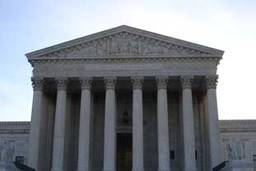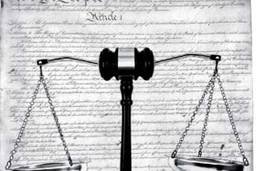Judging Harriet Miers
Democrats must rise up and challenge conservative claptrap about “activist judges”
Stephen J. Fortunato Jr.

The confirmation of John Roberts as Chief Justice of the United States Supreme Court and the nomination on October 3 of Harriet E. Miers as an Associate Justice are the right-wing’s exclamation points at the end of a line of neoconservative judges who have paraded onto the federal bench during George W. Bush’s presidency. Miers will provide no solace to those who think law in a constitutional democracy should protect individuals from official excesses and corporate predations.
Like John Roberts, Miers spent her professional career representing the interests of mega-corporations until she became a counselor to a right-wing administration. Like Roberts, her record is devoid of any work on behalf of poor people accused of crime or groups fighting for their civil rights (in a 1999 survey of the country’s largest law firms, The American Lawyer ranked the 206-lawyer firm headed by Miers as 53rd out of 69 comparably sized offices in terms of the amount of pro bono work provided to the community). And like Roberts she passes Bush’s unconstitutional prerequisite that federal judges have a religious faith. Her former pastor told The New York Times, “Harriet has placed her faith in Jesus.” This type of religiosity has been required by Bush of all his appointees, though Article VI of the United States Constitution unambiguously provides that “no religious test shall ever be required as a qualification to any office or public trust under the United States.”
Even though the confirmation hearings have yet to begin, Senator Harry Reid, the Democratic minority leader in the Senate, has given his imprimatur to Miers because she has a background as a trial lawyer. But the more important question is: for whom did she do battle in courtroom? Like Roberts, Miers carried briefs for the multinationals, not for poor people, not for persons facing the death penalty, and not for groups seeking judicial protection to exercise their civil rights. A background consisting of something more socially useful than assisting the rich to get richer becomes especially important when one considers that the Supreme Court hears only 90 cases annually that result in full opinions, and 25 percent of these regularly involve criminal law. The Supreme Court is in no small way responsible for the fact that our nation’s prisons house more then 2 million people, 50 percent of whom are disproportionately black and Hispanic, and many of whom are actually innocent according to recent studies. White, conservative, corporate attorneys will not fix this national scandal any time soon.
This relentless forward march of conservatives onto the federal bench has succeeded because Democrats, and the few Republican moderates left in the Senate, have been unable to craft cogent and comprehensible arguments to rebut the right’s mantra that a judge’s sole responsibility is to apply the law as written and not legislate from the bench. Bush draped this mantra around Harriet Miers’ shoulders at her nomination ceremony, just as he did earlier for Chief Justice Roberts. The mantra, however false, has served Bush well. The Democrats and their allies outside the Congress remain transfixed by the Republican’s constant din about “activist judges.”
The Democrat opposition fails to understand that the neoconservative argument cobbles together and conflates three legal premises that history and current practice rebut. First, following George W.’s one-note legal philosophy, Senators Frist, Hatch, et. al. claim federal judges should apply the law as written and not locate rights in the Constitution or create new law according to their subjective predilections. Second, the neocons maintain that judges must discern the original intent of the Founding Fathers when they examine constitutional claims. Third, they state that federal judges must defer to the will of the majority as reflected in laws enacted by Congress or policies pushed by the executive branch of government. All three criteria are ahistorical and illogical, but the Democrats, with few exceptions, have been too obtuse or too timid to expose and confront this fraudulent view of judging.
The first proposition – that the law simply awaits implementation by a judge – is indefensible on its face. If statutes and court decisions were as clear as this proposition suggests, there would not be dissents on appellate benches and law libraries would be one-tenth of their current size. Any conscientious lawyer or judge would surely admit that the forward-looking and comprehensive nature of statutory law cannot forecast every human controversy that will arise under it. Similarly, decisions by appeals courts are a pervaded by “loopholes.” A former and highly esteemed federal trial judge, Gerhard A. Gesell, put it plainly:
The fact is that I am absolutely bound by precedent. … There is, however, not much precedent out there, and frankly, precedent is frequently confused and goes both ways. … What a judge does to be fair and to get a fair result, which is the big thing, is to try to explore all those aspects to see how best that particular complex situation, whatever it is, fits our basic standards of decency.
The neoconservatives’ argument rests on the long-abandoned idea that the law on a given subject has always existed, much like a mineral in the ground, and all the judge has to do is scrape away the earth to locate it. This may have been Blackstone’s view in the late 1700s, but no responsible legal thinker holds to it now. There are certainly identifiable inalienable rights that inhere in all people, but this does not mean that laws governing all dimensions of human conduct currently exist and simply await discovery.
The second proposition-the “originalist” prong of the neoconservative argument-results from a similar journey into the land of smoke and mirrors. Of course, it is helpful for anyone seeking to apply the Constitution in a particular context to have some familiarity with constitutional history and the thoughts of the Founding Fathers; but it makes no sense to resolve contemporary problems solely according to the writings of 19th century politicians and philosophers. An appreciation of the views of the luminaries who assembled in Philadelphia in 1787 does not oblige us to abandon the observations of theoreticians since that time or to ignore advances in the technical and social sciences. The authors of the Constitution-and its ratifiers-deliberately left some terms vague: due process, probable cause, unreasonable search and seizure come immediately to mind.
The third position that serves as a neoconservative litmus test for judges-deference to the majority-is as misguided as the other two, but more cynical. The original Bill of Rights, as every high school student knows, as well as the 14th Amendment and its famed equal protection clause, are directed against the excesses of majorities, whether it is a legislature trying to prohibit freedom of expression or a police officer trying to enter a dwelling without probable cause and the appropriate legal authority to do so. Judges remain the bulwark that defends the individual against the intrusion of the legislature or the executive.
It is no surprise that right-wing heroes like Justices Antonin Scalia and Clarence Thomas join the pro-majoritarian chorus; after all, the majority for the last two decades has been shaped and molded by a mainstream media which largely excludes dissenting voices and which mirrors the reactionary politics of the conservative-corporate elite. So for the time being at least, neoconservative judicial philosophy is content to exalt majoritarianism as a democratic value far superior to any sensitivity to the rights of the marginalized.
To enhance their dominance in the larger society, the neocons advance an additional thesis with no grounding in the Constitution or the nation’s jurisprudential history. They insist that only the majority, acting through the legislature, can define a “new” right, be it abortion, the right to terminate one’s life with medical assistance, the right to seek a cure to spinal cord injury by stem cell research and so on. This theory would exclude judges from examining a claim that references the 9th Amendment to the United States’ Constitution-which declares that the Constitution’s enumeration of specific rights does not lead to an inference that no other rights enjoy legal protection.
At her confirmation hearing, Miers should be energetically questioned about her views on the locus of rights within the Constitution, the law’s frequent lack of clarity and certitude, the judge’s role as barrier between the individual and the government’s claimed prerogatives, and so on. Responding that she can not answer because a particular issue may come before the court simply will not wash when questions are put along these lines. Moreover, it would also be proper to inquire into her sensibilities, as well as her philosophy. In this era of “values,” it is fair to ask the former corporate mouthpiece what she thinks of the morality-not the legality-of the federal minimum wage of $5.15 an hour, or where she stands on torture and the Geneva Conventions.
There can be no doubt that Bush and his cronies seek to eliminate the role of the judiciary in protecting and expanding individual rights and curtailing draconian practices of government.
Like Karl Rove, Harriet Miers has functioned for more than a decade as an alter-ego and confidant of George W. Bush, so there is no reason to think that she will merit awards from the N.A.A.C.P. or the A.C.L.U. any time soon. Until the Democrats become more forceful and articulate in discrediting the neocons’ undemocratic agenda, we can expect the appointment of more judges like Harriet Miers who will spend their time obsequiously genuflecting before the legislature and the executive.






